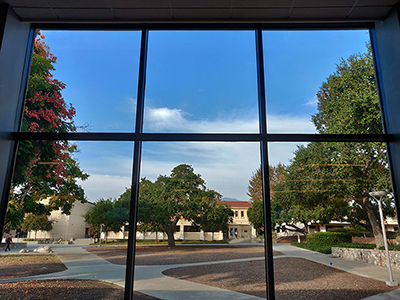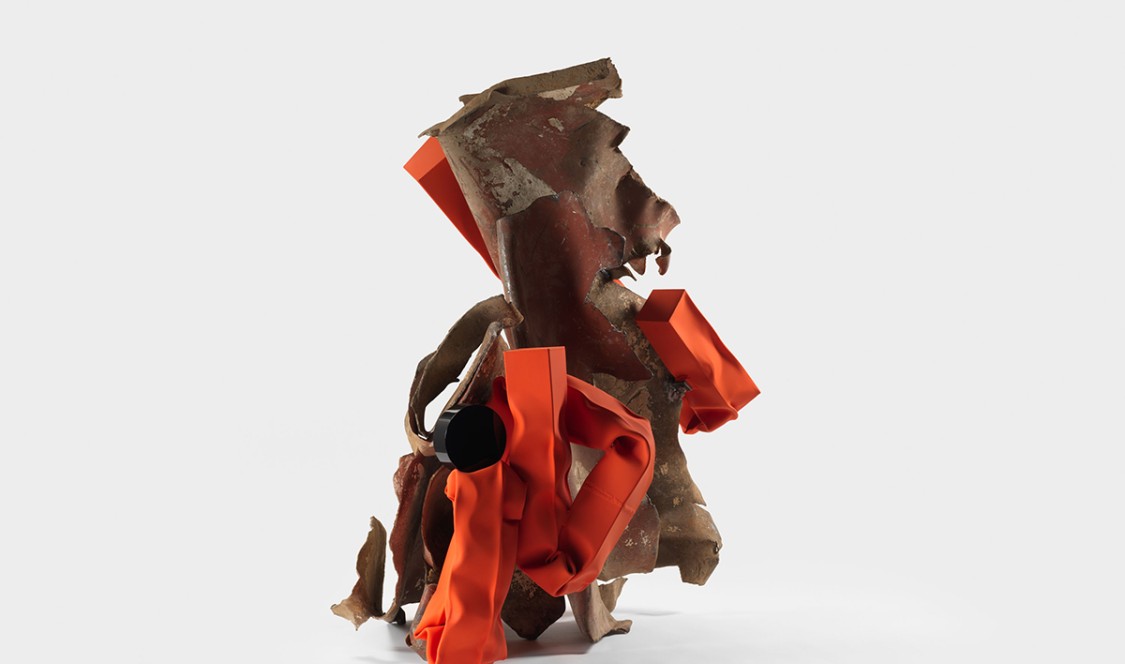About the Artist
Carol Bove (b. 1971), who was born in Geneva and grew up in Berkeley, California, studied at New York University, where she was later an associate professor of studio art. She has worked in Brooklyn’s Red Hook neighborhood since 2000, occupying a former brick factory filled with heavy machinery needed to create her enormous works.
She has had numerous solo exhibitions around the globe, including at The Museum of Modern Art in New York (2013), The Common Guild in Glasgow (2013), the Palais de Tokyo in Paris (2010), the Tate St. Ives in England (2009), and the Institute of Contemporary Art in Boston (2004). Bove has participated in group exhibitions internationally, including the Venice Biennale in Italy (2019, 2018, and 2011), documenta 13 in Kassel, Germany (2012), and the Whitney Biennial in New York (2008). Currently, she has a two-person exhibition with sculptor John Chamberlain at the San Francisco’s Museum of Modern Art. Bove has been represented by David Zwirner since 2011.
Four sculptures from the internationally renowned artist Carol Bove will be unveiled the week of January 13 just outside Collins Dining Hall as the latest addition to Claremont McKenna College’s distinguished public art collection.
The sculptures—two created for CMC and two previously exhibited to great acclaim in New York and Leeds, England—are a mixture of found metal, steel beams, petrified wood, and painted and polished stainless-steel tubing.Together they comprise Bove’s most extensive permanent public installation to date.
“We are getting to a critical mass of public art,” said Trustee Christopher Walker ’69, chair of CMC’s Public Art Committee, who commissioned and funded the Bove sculptures on the CMC campus.
Bove’s sculptures will join three other works installed in recent years to create a diagonal swath of significant public art on the CMC campus:
- an imposing painted and neon tube abstract mural by Mary Weatherford (b. 1963), titled “From the Mountain to the Sea,” in the Marian Miner Cook Athenaeum;
- an untitled 40-foot white-painted stainless-steel totem between Appleby and Phillips Halls, one of the last works created by celebrated artist Ellsworth Kelly (1923-2015);
- and “Meet in the Middle,” a sculpture of streetlights and benches in front of Roberts Pavilion, created by the conceptual artist Chris Burden (1945-2015).
The Carol Bove Acquisitions
The Bove sculptures were chosen by an art advisory panel of Trustees and prominent curators after reviewing proposals of four noteworthy artists. Each artist visited campus in the spring and summer of 2018 and selected a site for a proposed work, then submitted a formal presentation to the art advisory panel. Bove “instantly loved the site” on the quad outside Collins Dining Hall, Walker recalled, “among the four proposals, each on its own unique and creative, the panel was clearly drawn to Carol’s creative vision for the CMC campus, voting unanimously for its approval.”
Walker, an avid art collector who has donated and loaned many pieces to CMC, praised President Hiram E. Chodosh for his enthusiastic support.
“Hiram is a true visionary and appreciates how art makes a campus special,” he said.
Chodosh said the Bove sculptures “unleash the power to disrupt and inspire our engagement with the physical environment in which we live and learn.”
Walker, who has served on the Boards of the Los Angeles County Museum of Art and the Museum of Contemporary Art (Los Angeles) owns art by three of the four artists who made presentations, he has a Bove piece, “Cutting Corners,” inside his Los Angeles home. He had previously met Bove at art fairs, and in summer 2018 saw her exhibition at the David Zwirner gallery in London.
“It is the right moment in her career to have her first big public art commission in the heart of the campus,” Walker said.
Although Bove has two sculptures installed at the sculpture park at The Contemporary Austin in Texas—and has had several outdoor exhibitions, including on New York City’s High Line—the CMC sculptures are only her second public installation on the West Coast (the other is a white, looping, steel sculpture, titled “IO,” commissioned by the city of Beverly Hills).
Public art on campus inspires thoughtful conversation outside the classroom, according to CMC students, who are members of the Student Art Council.
"At CMC, students learn to respectfully engage with a variety of opinions and ideas," said CMC student Cristi Kennedy '21, who serves on the Student Art Council. "The upcoming Carol Bove installation reflects CMC’s intellectual mission to evoke critical inquiry."
Matiss Ozols '21, a CMC student and member of the Student Art Council, is excited that the Bove sculptures will be installed in a highly visible space, just outside Collins Dining Hall. "Art lives in many different forms and is all around us. We are taught to question and think critically in our classes and with art it should be no different. These will be an excellent addition to our campus and I hope the College continues to introduce new art for years to come.”
Philipp Kaiser, a well-known curator and the chief executive director of artists and programs at Marian Goodman Galleries in New York, Paris, and London, acted as a consultant to the committee. A former distinguished fellow in the humanities at CMC, Kaiser has been following Bove’s work for more than 15 years as he served on exhibition juries. He has seen her go through different creative phases.
“She’s a remarkable artist,” Kaiser said. He calls her large-scale pieces “both sensual and refined” and said that they make a bold claim for autonomous sculpture but are at the same time relational and talk to each other. “It’s sculpture about sculpture.”
Bove’s recent sculptures to be installed at CMC incorporate both found metal, gleaned from shipyards and scrap yards, and manipulated stainless steel tubing. Some of the tubing is crushed or folded, then painted, resulting in what critics describe as an almost fabric or clay-like appearance.
Her looping, tubular pieces are part of a family of sculptures that Bove calls “glyphs” (a glyph is a hieroglyphic character or symbol.)
Collage Sculptures
In the catalog published for Bove’s 2016 exhibition Polka Dots, arts scholar and curator Johanna Burton describes Bove’s work this way:

“The raw, found steel tends toward the lyrical in the way only things made by chance can be: in an effort to destroy or minimize massive lengths of junk steel, tools that compress or shred can lead to aesthetic results. Finally, the modified square tubes, prodded into shapes with a custom hydraulic press, are often dressed in paint that so fully melds with the metal as to look like its skin.”
One of the four sculptures that are to be installed were engineered and fabricated at Standard Sculpture in the Glassell Park neighborhood of Los Angeles. Owner Chris Grant has worked with Bove for five years. Standard Sculpture also is modifying the other three sculptures, which have previously been exhibited elsewhere, with new metal components to connect to footings for their permanent installation at CMC.
The four sculptures to be installed beginning on January 13 and over the course of three days, with the artist present on the initial day, are:
- “The Enigma of Pleasure” (2019). Made for CMC, this work includes scrap metal left in its rusted state, folded and crushed steel that has been painted orange, and a highly polished black steel disc. It is 80-inches high by 74-inches long and 46-inches wide.
- “Cretaceous” (2014). A second sculpture made from rusted mild (low carbon) steel and ancient petrified wood, this work was first shown in a joint Carol Bove/Carlo Scarpa exhibition that opened at the Museion - Museo d’Arte Moderna e Contemporanea, Italy, in 2014.
- “Lingam” (2015). Made of steel I-beams and 16-million-year old petrified wood, this installation was first exhibited in 2015 at David Zwirner in London as part of the artist’s solo presentation The Plastic Unit.
- “Four Loops” (2019). This white, looping tubular glyph was created for CMC. Measuring 267-inches long by 79-inches high and 34-inches wide, the loops will appear to float in space. They are constructed from 8-inch diameter stainless-steel pipes that are bent by multiple tons of hydraulic force. The raw steel is coated with many layers of sealant and liquid urethane and has been sanded and polished to a mirror-reflective surface.
A catalog about the Bove sculptures at CMC will be published in spring 2020, featuring an essay written by professor and chair of UCLA’s art history department Miwon Kwon and a conversation between the artist and Philipp Kaiser. Similar catalogs were published at the time of the Ellsworth Kelly, Chris Burden, and Mary Weatherford installations. The Kelly and Burden sculptures were donations from Trustee George Roberts ’66, P ’93. The Weatherford mural was acquired for the College by a group of trustees on the Public Art Committee in 2014.
Public Art Vision
Walker summed up the committee’s philosophy concerning public art acquisitions for CMC.
“We’re not going to have a museum. We’re not going to have a sculpture garden,” he said. “These sculptures along with other present and future public art loans, gifts, and acquisitions throughout the campus are going to be part of the academic life at CMC.”
To that end, Walker said, confetti seating will be installed near the Bove installation next summer so that students can contemplate the sculptures at length.
“Chris Walker’s extraordinary generosity and leadership and Carol Bove’s vision and brilliant creativity join here to put the public arts in the heart of the liberal arts at CMC,” said Chodosh.
—Allison Engel

